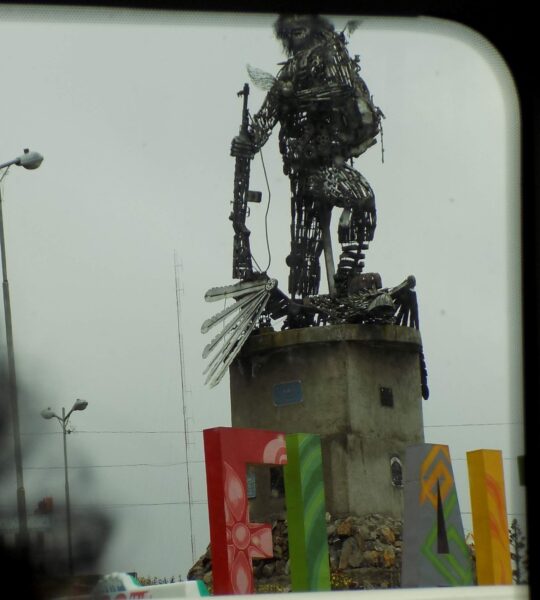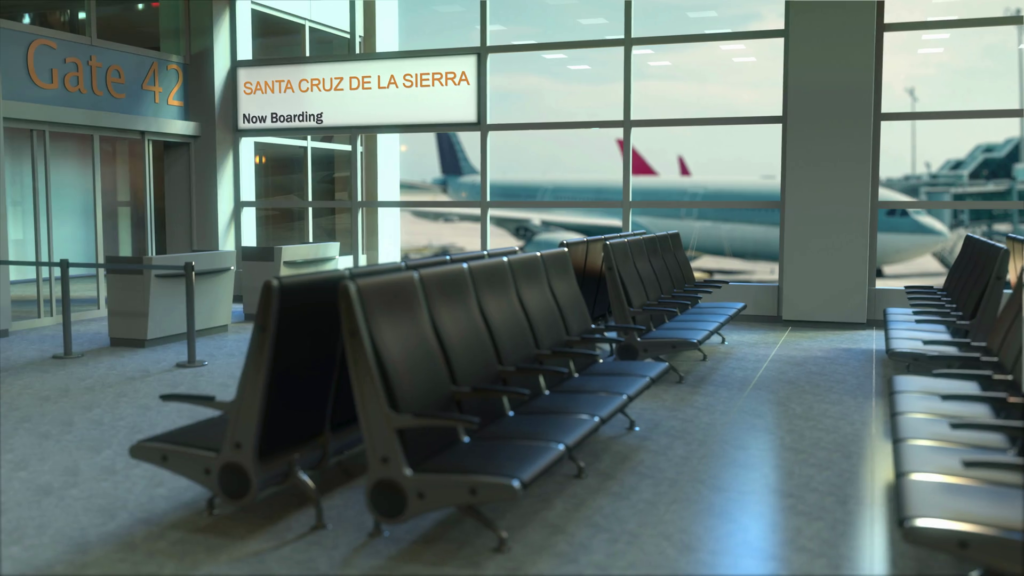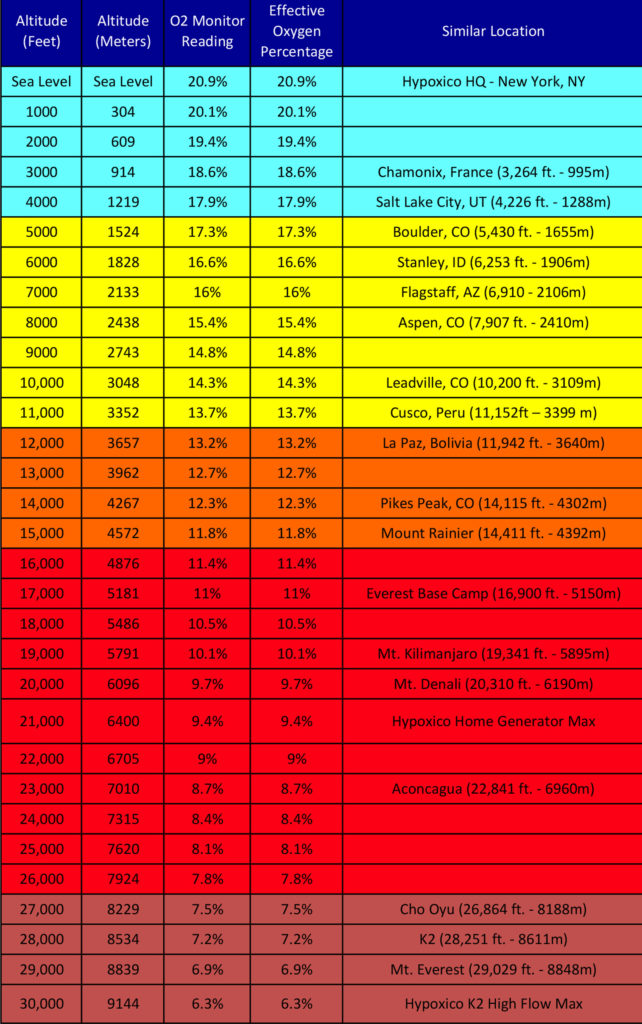Bolivia, Bolivia, have you met Bolivia.
As I noted at the end of the previous post, for us, Paraguay was little more than a way stop between our days at Iguazú and our time in La Paz – the capital of Bolivia. While we made the first journey by bus, this leg involved two short flights. The first took us from Asunción to Santa Cruz and from there we flew to El Alto – the location of the airport that serves La Paz. (By the way, the local people pronounce this with no clear phonetic juncture, stressing the second syllable, and a voiceless alveolar sibilant. Thus, luhPAHSS.) Before I reveal why I chose to be specific about the location of the airport in El Alto, I’ll tell you the tale of my time at the airport in Santa Cruz.
In a previous post I mentioned that as an American I needed a visa to enter Bolivia. I didn’t acquire it in advance because JLA didn’t suggest it and I’d seen no material indicating that obtaining one at the airport would be at all difficult. As it turns out, this was an anxiety producing oversight.
As I expected, Bolivian immigration asked to see my visa. When I told them I needed to purchase it, they pointed me to a waiting area and indicated I should sit there. Some minutes passed as everyone else on the plane including Berner, Jan, and Jill (who, as UK citizens, didn’t need a visa) passed through immigration.
Another 10 minutes or so elapsed before someone from Immigration approached and began asking for documents. The first document they wanted to see was one that showed how and when I’d be leaving the country. I didn’t have it. It’s likely that no one had it. Since we were leaving by bus and crossing into Peru along Lake Titikaka, it’s probable that Berner hadn’t yet procured them. Fortunately, I was able to navigate that hazard by showing my flight itinerary with my departure from Lima at the end of the month.
The second document was more problematic. They wanted to see confirmation of my hotel reservation. The only paperwork I had was the name and address of the hotel in La Paz that JLA had sent me. This wasn’t sufficient. Time was ticking. I had a connecting flight to meet and Berner was nowhere in sight.
The agents tried calling the hotel. The call wouldn’t go through. More minutes passed. One agent connected me to her phone through a WiFi hotspot so I could try to call. The call wouldn’t go through. More minutes passed. I was still alone and I began having visions of Tom Hanks in The Terminal.
(While we left for El Alto from an area similar to this, this picture of an airport waiting area is from Storyblocks.com and is, again to provide a resting spot for your eyes.)
More time passed. It was 11:30 and I had a noon flight. Finally the paperwork came through and the process began – surrender my passport, remove my hat and glasses, have my photo taken, and so on. In what I thought was the nick of time, they produced the document and now I had to pay for it. Cash only. One hundred sixty American dollars or about 1,100 Bolivian bolivianos. Fortunately, I had the former.
Berner told me my anxiety had been a bit overblown. He said that the hotel had sent the data long before immigration indicated they had it but they had wanted to involve as many layers of their internal bureaucracy as possible and that they probably enjoyed seeing me squirm a bit. He also reminded me that we’d crossed time zones and I had an hour longer than my anxiety had conjured. (My phone, of course, wouldn’t adjust its time setting until it had a data connection.) It’s not even fun in retrospect.
Andes Mountain High in El Alto.
If you’ve been with me on this journey since the beginning of my recounting, you may recall that my body underwent a bit of a shock encountering the sudden transition from the cold of the late Baltimore winter to the heat of a late Rio summer. Landing in El Alto (which means The High) generated the second physical shock of the trip. When we left Silvio Pettirossi International in Asunción at about 08:30 Tuesday we were about 150 meters above sea level. Just shy of two hours later we arrived in another relatively low altitude city, Santa Cruz de la Sierra which sits 400 meters or so above sea level.
After my adventure at immigration, we boarded the plane for El Alto International where we were scheduled to touch down at about 13:00. There’s a reason the city is called The High. Its altitude is 4,150 meters or more than 10 times the distance above sea-level than is Santa Cruz. The flight was a bit more than an hour so when I tell you that arriving in El Alto quickly left me gasping for breath, I mean that literally.
The chart below from the aptly named hypoxico.com website provides some idea
of the effective drop in oxygen. (The amount of oxygen in the atmosphere remains constant. However, barometric pressure decreases as altitude increases. This decrease in pressure allows the oxygen molecules to be farther apart and this reduces the oxygen content available for each breath.)
You might notice that El Alto is about the same altitude as the top of Pikes Peak, Colorado a location that most visitors handle in relative comfort. The difference is that most people who visit this famous mountain have probably spent some time in nearby Colorado Springs which is at about 1,800 meters so they’ve had at least some minimal acclimatization. We had none. And the fact that we would descend 500 meters or so into La Paz made little difference.
Fortunately, at the end of the day, none of us would suffer significantly from symptoms of altitude sickness. Berner, who’s spent his life at altitude, felt nothing. Jill had come prepared with some preventive medication and so transitioned a bit more easily than Jan and I who “toughed it out.” For the next week or so I woke each morning with a headache but one that was quite manageable with a dose of acetaminophen (or paracetamol as they call it elsewhere around the globe). In La Paz I also had two or three nose bleeds but our local guide assured me that this was a signal of pressure relief. Since they didn’t recur, I concluded her diagnosis was correct.
Although we arrived early in the afternoon, we all (excepting Berner) quickly realized a day of minimal activity was in order. We drove the long route (about 15 kilometers) to the hotel passing this statue of Ché Guevara along the route,

had a brief walk before dinner to familiarize ourselves with the immediate area, and had dinner in the hotel before retiring for the night.
I had a traditional quinoa soup that was delicious but that was also about all my body seemed ready to tolerate in part because I’d been drinking high calorie beverages (Coke, Gatorade, and the like because the coca and electrolytes are purportedly helpful at high altitude) throughout the day and partly because it was at about this time that I manifested the early symptoms of a mild cold that would niggle me for the coming week or so. Jan suggested that the symptoms also indicated the possibility of dehydration – a condition not uncommon at altitude.
If she was right, I was facing the aging male dehydration dilemma – drink more and all but guarantee an interrupted sleep or drink less, sleep through the night, but potentially face similar symptoms on the morrow. I chose a middle path supplementing the chicken stock based soup (“It couldn’t hoit!”) with a cup or two of coca tea. (I’ll have much more to say about the coca plant and its leaves in an upcoming entry.)
Here are a few pictures from the day.
And in answer to today’s, “What in the world was he thinking?” reference, I give you Groucho.
(The second reference “Andes Mountain High” is intended to invoke a certain John Denver song.)
See you next time.

